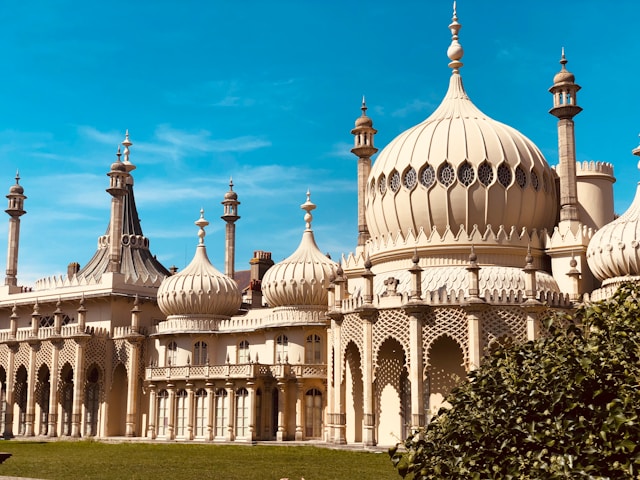
History
Brighton’s Royal Pavilion was chiefly designed by the architect John Nash, who has been called “the Prince Regent’s favourite architect.” The Pavilion was initially built as a seaside retreat for the Prince of Wales who would later become King George IV. Construction took place from 1787 to 1823 with the original plan for a simple farmhouse evolving to the magnificent palace we see today. Nash infused the building with Indo-Saracenic architecture, which is known for exotic domes, minarets, and intricate ornamentation. The Pavilion served as a royal residence, but also as a venue for grand banquets and extravagant parties. Its interior is adorned with luxurious furniture, ornate decorations, and artistic masterpieces, including a previously unseen painting by John Constable that went on display in 2022.
Architecture
The Royal Pavilion is renowned for its distinctive architecture. The exterior features a unique combination of domes and spires, with the most notable being the large central dome topped with a gilded dragon. The Pavilion’s cream-coloured render and bright blue tiles are unmistakable, even from a distance. Brighton and Hove Albion wore a commemorative away shirt in the 2023-2024 season, for their first ever campaign in European football, that featured the Pavilion on the front in a white and turquoise design.
The Pavilion has undergone various restorations over the years. John Goodall, architectural editor of Country Life, praised the Royal Pavilion’s 2019 restoration. Goodall wrote, “This exemplary project has been in the planning for about 15 years, involving some remarkable detective work and an enormous breadth of expertise.” Modern doors, including those made with white oak and internal glass doors are more commonly used in buildings today. But the Pavilion’s restorations have focused on preserving its historic character and grandeur rather than integrating modern materials.
Gardens
Beautiful gardens surround the Pavilion and reflect the Regency style with carefully manicured lawns and vibrant flower beds. The gardens offer a peaceful oasis in the city centre, with a stunning collection of exotic plants, many of which were imported from the far corners of the globe. In 2023, Brighton & Hove City Council announced £4.4m plans to redesign and restore the gardens.
Culture
The Pavilion played a significant role in British cultural history. The Royal Collection Trust writes that during King George IV’s reign, the king used the Pavilion as an escape from London and “the stiff formality of life there.” Brighton offered a chance for George to enjoy music, balls, and banquets. After George IV died, it was used for various purposes, including as a residence for William IV and Queen Victoria, and then as a hospital during World War 1. Before the war, the Pavilion was under threat of demolition, before, Goodall wrote, “Famously, and in the teeth of opposition,” the town council bought the building. In the 1920s, the Pavilion was restored and opened to the public, allowing more people to learn about its past. Today, the Pavilion serves as a museum and one of Brighton’s main tourist attractions.
Experience
Visitors to the Pavilion can take guided tours or explore the rooms themselves. The self-guided audio tours offer insights into the history and architecture of the Pavilion. The interior is meticulously preserved and allows guests to appreciate the craftsmanship, full of intricate details, that went into its design. The Royal Collection Trust notes, “In 1864 and throughout the 1920s, Queen Victoria (1819–1901) and Queen Mary (1867–1953) returned many of the Pavilion’s original furnishings and fittings, which were incorporated into the restoration.” For the 2019 renovation, carpet designer Jess Shaw, took six months digitising the design for an accurate recreation. The original carpet cost £620 – extraordinary money at the time.
